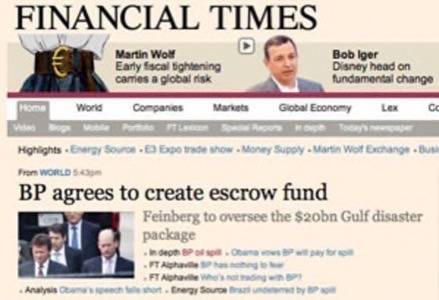A report yesterday from PricewaterhouseCoopers found that online ad revenue is on the verge of surpassing print ads – an inspiring milestone for new media and convergence. However, the PwC survey was based on combined figures across all online media outlets; are individual news outlets having success detaching themselves from the traditional print ad revenue addiction? The Financial Times, London’s version of the Wall Street Journal, says it has leveraged its niche market and will see print ad revenues dip below direct payments made to the paper this year, according to the Los Angeles Times.

So what does “direct payment” mean in this case? For the Financial Times, it means subscriptions to its print circulation – which costs readers roughly £235 ($348 U.S.) for a year’s subscription – and for access to the paper’s content online at a price of around £125 ($186 U.S.). But the newspaper has created alternative sources of revenue as well, including iPhone and iPad applications and a series of glitzy events and conferences drawing luminaries from various industries.
Earlier this month, we mentioned that the Financial Times had reached 130,000 downloads of its free iPad application in its first two weeks. The app is being downloaded nearly ten times faster than its iPhone companion, which launched last year but required an online subscription to use. All this just from the U.S. launch of the app; the U.K. version has yet to be released into the AppStore.

The faster pace of downloads is likely due to the fact that the app is free, and provides access to the Financial Times content that is normally behind subscriptions. The newspaper is running a two-month sponsorship to fund the app and grow its popularity, and will likely switch to a monthly subscription model soon.
One reason why a digital subscription via the iPad is likely to succeed for the Financial Times is because much of the readership of the paper (like that of the Wall Street Journal) is mainly wealthy financiers and business executives – just the type of audience that’s likely to subscribe and more likely to own the expensive iPad. According to the Los Angeles Times story, the paper estimates that by 2012 a full third of its revenue will come from its digital efforts. As with the report regarding online ad revenues from yesterday, this news from the Financial Times is very encouraging for the online media industry.
But the Financial Times is leveraging its upper-class audience in other ways as well. According to the Los Angeles Times, the paper hosts events and conferences aimed at these high-rollers. At the forefront of these events is the Business of Luxury Summit, which has become a strong source of profit for the paper thanks to high-end sponsorships and expensive registration prices, with executives from companies like Estee Lauder, Calvin Klein and Jimmy Choo drawing in the wealthy attendees.
The ability of traditional news outlets to break their dependence on print ad revenues is certainly a welcome change and a good sign that the industry can in fact survive at a healthy level online. The Financial Times, however, may be a poor example since they have a significantly different audience – one that may be more willing to pay for an online subscription.

















